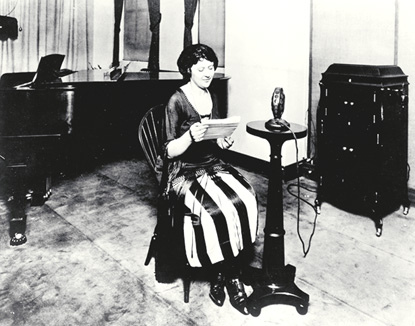
1922 - 1926: AT&T was the most important company in the programming side of U.S. broadcasting with advertising-supported radio network.
1926 - AT&T sold WEAF to RCA for $1 million.
Radio
In 1920, radio was first developed, primarily for use by the military, strictly for sending messages from one location to another. David Sternoff, the then-president of RCA (Radio Corporation of America), first had the idea to sell radio sets to consumers, or what were then called radio receivers. However, consumers needed a reason to buy radios, so RCA was the first to set up radio stations all over the country. Between 1920 and 1922, 400 radio stations were set up, starting with KBKA in Pittsburgh. Stations were also set up by universities, newspapers, police departments, hotels, and labor unions.The biggest difference in radio before and after 1923 was that the first advertising was not heard on the radio until 1923. RCA at the time was made up of four companies:
AT&T (American Telephone & Telegraph Corporation), General Electric, United Fruit and Westinghouse.
United Fruit was one of the first global corporations, and one of the first to advertise on the radio. The AT&T division of RCA first thought about selling time on the air to companies, which marked the start of "toll broadcasting." WEAF was the first station to operate this way, causing widespread outrage, and accusation of "polluting the airwaves."
 |
August 28, 1922 - AT&T opened WEAF, the first commercial radio
station in New York (announcer Helen Hahn in the WEAF studio). 1922 - 1926: AT&T was the most important company in the programming side of U.S. broadcasting with advertising-supported radio network. 1926 - AT&T sold WEAF to RCA for $1 million. |
Because of this controversy, the practice of selling advertising time was called "trade name publicity." Sponsors linked their name with a program on the air, rather than advertising a specific product in a 30 second "commercial" as we know it today.
Why did AT&T decide to experiment with charging
companies for air time?
AT&T was not making any money from broadcasting at
the time since they only made transmitters, not
receivers. They only made money when new radio stations
bought the equipment required to broadcast. They did not
make money from consumers buying radios.
AT&T also started the practice of paying performers
for their time on the air, rather than only volunteers,
which was standard practice for radio content up until
that point.
The first radio network
In 1926, RCA set up the first radio network, NBC
(National Broadcasting Corporation). They decided it was more effective and efficient to
produce shows in New York City, and then link the main
radio station with stations all across the country,
connected by AT&T (another RCA company) phone lines.
(Today television networks are linked by satellite to
their affiliates).
This was the beginning of the network affiliates
system. The ideal network makes sure everyone in the
country is capable of listening to their signal.
NBC at the time had two philosophies:
Radio content was a "public service," whose function was to sell radios.
Radio content was designed to generate income from advertising.
In 1927, the second network was formed. It was CBS (Columbia Broadcasting System), started by William Paley. Paley was the first to think that networks could make money strictly from advertising, not even getting involved in the sales of radios. Like AT&T, CBS did not make radios. From the start, they made their money from selling advertising.
The rising of radio networks caused the Radio Act of 1927 to be passed, which established the FRC (Federal Radio Commission), or what is now known as the FCC (Federal Communications Commission), to allocate broadcast licenses. The need for such an organization was brought on by the fact that airwaves are limited resources, and broadcasting itself is a scarce public resource. By the 1930's, the structure of radio have been set by the commercial format, although advertising never dominated radio like it would television later on.
In the 1920's and '30's, radio programs were divided into two groups. Sponsored shows, which had advertisers, and unsponsored shows, which did not. The radio station paid for the unsponsored shows. The sponsored shows, on the other hand, were created entirely by the company sponsoring the show; advertisers were totally in charge of the radio station's content. The content became advertising. Radio set the precedent for television, in that the same companies that controlled radio early on went on to control television. EzineArticles.com